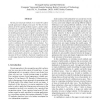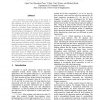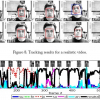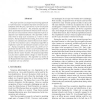134
click to vote
FGR
2008
IEEE
15 years 7 months ago
2008
IEEE
Recent pose invariant methods try to model the subject specific appearance change across pose. For this, however, almost all of the existing methods require a perfect alignment b...
100
click to vote
FGR
2008
IEEE
15 years 7 months ago
2008
IEEE
This paper summarizes a study carried out on data from the Face Recognition Vendor Test 2006 (FRVT 2006). The finding of greatest practical importance is the discovery of a stron...
119
click to vote
FGR
2008
IEEE
15 years 7 months ago
2008
IEEE
Face information processing relies on the quality of data resource. From the data modality point of view, a face database can be 2D or 3D, and static or dynamic. From the task poi...
112
click to vote
FGR
2008
IEEE
15 years 7 months ago
2008
IEEE
We present a real-time user-independent computer vision system that processes a sequence of images of a front-facing human face and recognises a set of facial expressions at 30 fp...
123
Voted
FGR
2008
IEEE
15 years 7 months ago
2008
IEEE
Active shape model (ASM) statistically represents a shape by a set of well-defined landmark points and models object variations using principal component analysis (PCA). However, ...
101
click to vote
FGR
2008
IEEE
15 years 7 months ago
2008
IEEE
We present an approach to learning the personal preferences of individual users directly from example images. The target application is computer assisted search of partners in onl...
FGR
2008
IEEE
15 years 7 months ago
2008
IEEE
We recognize faces from our own race better than those from another race. Although the relative contribution of different mechanisms (e.g. contact vs. attention) remains elusive, ...
120
click to vote
FGR
2008
IEEE
15 years 7 months ago
2008
IEEE
This paper presents an unsupervised learning approach to video-based face recognition that does not make any assumptions about the pose, expressions or prior localization of landm...
108
click to vote
FGR
2008
IEEE
15 years 7 months ago
2008
IEEE
In this paper, we focus on the reliable detection of facial fiducial points, such as eye, eyebrow and mouth corners. The proposed algorithm aims to improve automatic landmarking ...
102
click to vote
FGR
2008
IEEE
15 years 7 months ago
2008
IEEE
A robust VAR-based (vector autoregressive) model is introduced for motion prediction in 3D hand tracking. This dynamic VAR motion model is learned in an online manner. The kinemat...




